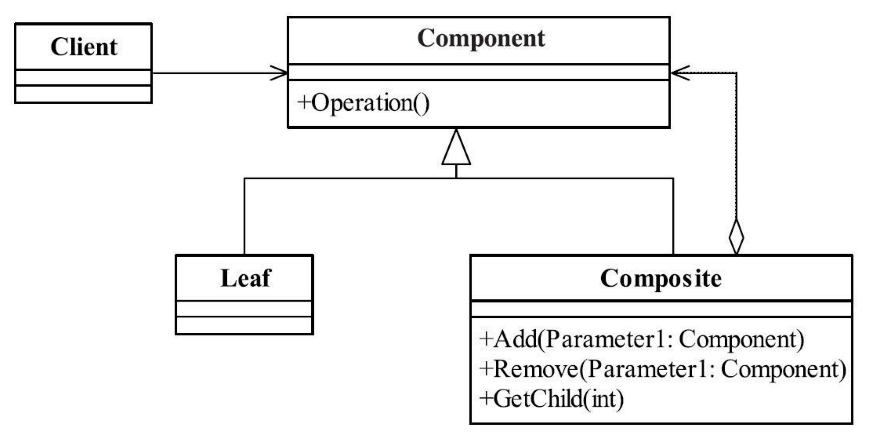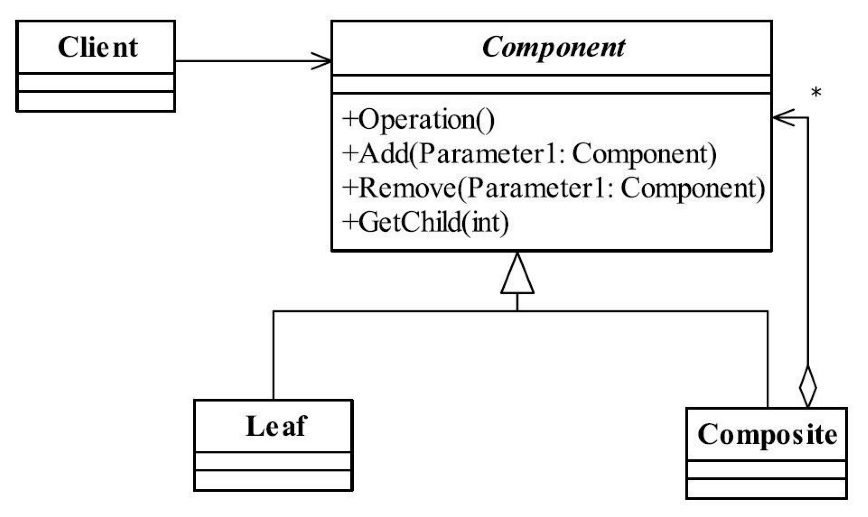一、前言 组合模式解决的问题是:树形结构(部分与整体的层次结构)
组合模式(Composite Pattern)也叫合成模式,有时又叫做部分-整体模式(Part-Whole),主要是用来描述部分与整体的关系,
二、基本概念 1.定义 将对象组合成树形结构以表示“部分-整体”的层次结构,使得用户对单个对象和组合对象的使用具有一致性。
Compose objects into tree structures to represent part-whole hierarchies.Composite lets clients treat individual objects and compositions of objects uniformly.
分为:
2.优劣 2.1 优点 (1)高层模块调用简单
一棵树形机构中的所有节点都是Component,局部和整体对调用者来说没有任何区别,也就是说,高层模块不必关心自己处理的是单个对象还是整个组合结构,简化了高层模块的代码。
(2)节点增加自由
2.2 缺点 (1)违背依赖倒置原则
违背依赖倒置原则,破坏面向接口编程,场景类中直接使用实现类。
3.适用场景 只要涉及到部分-整体关系、树形结构,就可考虑使用组合模式。
(1)维护和展示部分-整体关系的场景,如树形菜单、文件和文件夹管理。
(2)从一个整体中能够独立出部分模块或功能的场景。
4.最佳实践 只要涉及到部分-整体关系、树形结构,就可考虑使用组合模式。
三、安全模式 1.登场角色 安全模式的通用类图
1.1 Component(抽象节点) 定义参加组合对象的共有方法和属性,可以定义一些默认的行为或属性,
1.2 Leaf(叶子节点) 叶子节点
1.3 Composite(非叶子节点) 树枝节点,职责是组合树枝节点和叶子节点形成一个树形结构。
2.通用源码 2.1 Component 1 2 3 4 5 6 7 8 9 10 public abstract class Component { public void doSomething () { } }
2.2 Composite 1 2 3 4 5 6 7 8 9 10 11 12 13 14 15 16 17 18 19 20 21 22 public class Composite extends Component { private ArrayList<Component> componentArrayList = new ArrayList <Component>(); public void add (Component component) { this .componentArrayList.add(component); } public void remove (Component component) { this .componentArrayList.remove(component); } public ArrayList<Component> getChildren () { return this .componentArrayList; } }
2.3 Leaf 空接口有何意义呀?有意义!它是每个叶子节点的代表,系统扩容的时候你就会发现它是多么“栋梁”。
1 2 3 4 5 6 7 8 public class Leaf extends Component { }
2.4 Client 1 2 3 4 5 6 7 8 9 10 11 12 13 14 15 16 17 18 19 20 21 22 23 24 25 26 27 28 29 30 public class Client { public static void main (String[] args) { Composite root = new Composite (); root.doSomething(); Composite branch = new Composite (); Leaf leaf = new Leaf (); root.add(branch); branch.add(leaf); } public static void display (Composite root) { for (Component c : root.getChildren()) { if (c instanceof Leaf) { c.doSomething(); } else { display((Composite) c); } } } }
四、透明模式 1.登场角色
(1)透明模式与安全模式的区别
透明模式是把用来组合使用的方法放到抽象类中,然后通过判断是getChildren的返回值确认是叶子节点还是树枝节点。
(2)不安全的原因
透明模式是把用来组合使用的方法放到抽象类中,比如add()、remove()以及getChildren等方法(顺便说一下,getChildren一般返回的结果为Iterable的实现类,很多,大家可以看JDK的帮助),不管叶子对象还是树枝对象都有相同的结构,通过判断是getChildren的返回值确认是叶子节点还是树枝节点,如果处理不当,这个会在运行期出现问题,不是很建议的方式;安全模式就不同了,它是把树枝节点和树叶节点彻底分开,树枝节点单独拥有用来组合的方法,这种方法比较安全,我们的例子使用了安全模式。
2.通用源码 2.1 Component 抽象构件定义了树枝节点和树叶节点都必须具有的方法和属性,这样树枝节点的实现就不需要任何变化
1 2 3 4 5 6 7 8 9 10 11 12 13 14 15 16 17 18 19 public abstract class Component { public void doSomething () { } public abstract void add (Component component) ; public abstract void remove (Component component) ; public abstract ArrayList<Component> getChildren () ; }
2.2 Leaf 树叶节点继承了Component抽象类,不想让它改变有点难,它必须实现三个抽象方法,因此给个空方法。
1 2 3 4 5 6 7 8 9 10 11 12 13 14 15 16 17 18 19 20 21 22 public class Leaf extends Component { @Deprecated public void add (Component component) throws UnsupportedOperationException { throw new UnsupportedOperationException (); } @Deprecated public void remove (Component component) throws UnsupportedOperationException { throw new UnsupportedOperationException (); } @Deprecated public ArrayList<Component> getChildren () throws UnsupportedOperationException { throw new UnsupportedOperationException (); } }
为什么要加个Deprecated注解呢?就是在编译器期告诉调用者,你可以调我这个方法,但是可能出现错误哦,我已经告诉你“该方法已经失效”了,你还使用那在运行期也会抛出UnsupportedOperationException异常。
2.3 Composite 1 2 3 4 5 6 7 8 9 10 11 12 13 14 15 16 17 18 19 20 21 22 public class Composite extends Component { private ArrayList<Component> componentArrayList = new ArrayList <Component>(); public void add (Component component) { this .componentArrayList.add(component); } public void remove (Component component) { this .componentArrayList.remove(component); } public ArrayList<Component> getChildren () { return this .componentArrayList; } }
2.4 Client 1 2 3 4 5 6 7 8 9 10 11 12 13 14 15 16 17 18 19 20 21 22 23 24 25 26 27 28 29 30 public class Client { public static void main (String[] args) { Composite root = new Composite (); root.doSomething(); Composite branch = new Composite (); Leaf leaf = new Leaf (); root.add(branch); branch.add(leaf); } public static void display (Component root) { for (Component c : root.getChildren()) { if (c instanceof Leaf) { c.doSomething(); } else { display(c); } } } }

